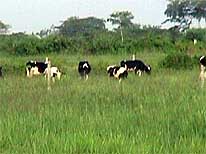|
Other Places |
|||||||||||||||||
|
|
|||||||||||||||||
|
Other Sections |
|||||||||||||||||
|
|
|||||||||||||||||
|
Las Tunas, the western province, is the less developed and certainly the poorer of the two. Its entire economy relies on sugarcane crops and livestock. Las Tunas is actually quite well Historically, as one of the most impoverished areas during the 1900's, these provinces have shown strong support for Castro and other revolutionaries seeking to bring change for the benefit of the poor and downtrodden. Despite Cuba's recent economic troubles (which are arguably due more to repressive U.S. economic policies than incompetence in Castro's government), the province of Las Tunas has remained a center of loyalty to Fidel. The city of Victoria de Las Tunas (the province's capital) is small and generally unremarkable; while it is fairly modern, there are no especially outstanding works of art or industry to see. Supposedly, the capital is named la Victoria de Las Tunas (rather than just Las Tunas) to commemorate a Spanish victory over Cuban rebels in a battle there during the 1800's. Foreigners generally skip over Victoria de Las Tunas, as any historical buildings and atmosphere the city might have was destroyed when it was razed to the ground by rebel forces in 1895. The province of Holguín, east of Las Tunas, is perhaps a bit more interesting than Las Tunas; it is more heavily populated, features a more varied terrain, and has a much more diverse economy. Holguín features an interesting mix of different geographical features. In the east, various small mountain ranges rise up above the landscape, most prominently Las Alturas de Moa. The western half of the province is very lush and forested, while the southern half fades into dry grassland bordering the provinces of Granma, Santiago de Cuba, and Guantánamo. Just as Holguín's landscape is varied throughout the province, its economy is as well. Whereas Las Tunas to the west relies on agricultural production to sustain its local economy, Holguín has developed a significant industrial sector in the cities based on its mineral resources, and begun to build a local tourist industry, all the while not abandoning lucrative sugarcane and citrus crops.
|
|||
 The provinces of Las Tunas and Holguín make up much of the general area of eastern Cuba traditionally known as "El Oriente."
The provinces of Las Tunas and Holguín make up much of the general area of eastern Cuba traditionally known as "El Oriente." suited to sugarcane crops, as it has good soil, and is mainly flat grassland (except for swampy areas along the coasts which are agriculturally useless). Travel books often describe the terrain of Las Tunas as boring because it is essentially flat and features little significant vegetation besides sugarcane as far as the eye can see.
suited to sugarcane crops, as it has good soil, and is mainly flat grassland (except for swampy areas along the coasts which are agriculturally useless). Travel books often describe the terrain of Las Tunas as boring because it is essentially flat and features little significant vegetation besides sugarcane as far as the eye can see.